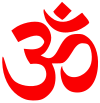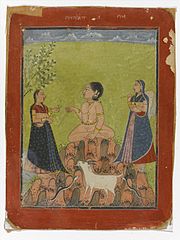Malkauns
 | |
| Thaat | Bhairavi |
|---|---|
| Type | Audava |
| Time of day | Late night, 12–3 |
| Arohana | .ni. Sa ga Ma dha ni *Sa* |
| Avarohana |
|
| Synonym |
|
| Equivalent | Hindolam |
| Hindustani classical music | ||||||
|---|---|---|---|---|---|---|
| Concepts | ||||||
| Instruments | ||||||
|
||||||
| Genres | ||||||
|
||||||
| Thaats | ||||||
| Part of a series on |
| Hindu scriptures and texts |
|---|
 |
| Related Hindu texts |
Malkauns is a raga in Indian classical music. It is one of the oldest ragas of Indian classical music.[1] The equivalent raga in Carnatic music is called Hindolam, not to be confused with the Hindustani Hindol.
According to Indian classical vocalist Pandit Jasraj, Malkauns is a raga that is "sung during small hours of the morning, just after midnight." He further adds that the raga has a soothing and intoxicating effect.[2]
Etymology[edit | edit source]
The name Malkaush is derived from the combination of Mal and Kaushik, which means he who wears serpents like garlands – the god Shiva. However, the Malav-Kaushik mentioned in classical texts does not appear to be the same as the Malkauns performed today.[3] The raga is believed to have been created by goddess Parvati to calm lord Shiva, when he was outraged and refused to calm down after Tandav in rage of Sati's sacrifice.[2]
In Jainism, it is also stated that the Raga Malkauns is used by the Tirthankaras with the Ardhamāgadhi Language when they are giving Deshna (Lectures) in the Samavasarana.
Malkaush belongs to Shaivait musical school; in fact most pentatonic ragas belong to Shaivait musical school.[1]
Shiv ttva ratnakara, 6, 8, 67[1]
Arohana and Avarohana[edit | edit source]
Malkauns belongs to the Bhairavi thaat. Its notes are Sa, komal Ga, shuddh Ma, komal Dha, and komal Ni. In Western classical notation, its notes can be denoted as: tonic, minor third, perfect fourth, minor sixth and minor seventh. In raga Malkauns, Rishabh (Re – second) and Pancham (Pa – perfect fifth) are completely omitted. Its jaati is audav-audav (five-five, that is, pentatonic).[4]
Arohana : .ni. Sa ga Ma dha ni *Sa*
Avarohana : *Sa* ni dha Ma ga Ma ga Sa OR *Sa* ni dha Ma ga Sa
The 'Ga' used is actually Ga-Sadharan (the rough minor third), 316-cent above Sa[5]
Vadi and Samavadi[edit | edit source]
The vadi swara is Madhyam (Ma) while the Samavadi swara is Shadaj (Sa).
Pakad or Chalan[edit | edit source]
Pakad : ga ma dha ma ga ma ga sa
Other characteristics[edit | edit source]

Malkauns is a serious, meditative raga, and is developed mostly in the lower octave (mandra saptak) and in a slow tempo (vilambit laya). Ornaments such as meend, gamak and andolan are used rather than 'lighter' ornaments such as murki and khatka. Komal Ni is generally considered the starting note (graha swara), and the notes komal Ga and komal Dha are performed with vibrato (andolit). All five swaras can function as pausing notes.
The komal Ni in Malkauns is different from the komal Ni in Bhimpalasi.
The best time for this raga is late night. The effect of the raga is soothing and intoxicating.
Related ragas[edit | edit source]
Some related ragas are Chandrakauns, Bageshri-Ang Chandrakauns, Nandkauns, Sampoorna Malkauns, Pancham Malkauns, Kausi Kanada, Madhukauns, Jogkauns, Nirmalkauns and Tulsikauns.
Film songs[edit | edit source]
'Man Tarpat Hari Darshan Ko Aaj' (film Baiju Bawra, performed by Mohammad Rafi), 'Aadha Hai Chandrama Raat Aadhi' (film Navrang, performed by Mahendra Kapoor and Asha Bhosle), 'Chham Chham Ghunghroo Bole' (film Kaajal, performed by Asha Bhosle), 'Ankhiyan Sang Ankhiyaan Laagi Aaj' (film Bada Aadmi), 'Balma Maane Na' (film Opera House) and 'Rang raliyaan karat sautan sang' (film Birbal My Brother), 'Gori tera gaon bada pyara' (film Chitchor, performed by K.J. Yesudas), 'Ek Ladki Thi' (film Love You Hamesha, performed by Kavita Krishnamurthy) are a few Hindi film compositions based on Malkauns. 'Rajasekhara' in the film 'Anarkali' in Tamil and Telugu is a composition based on this in South India. "Ohm Namashivaya" and "Margazhi Poove" songs in Tamil by Illayaraja and AR Rahman from Salangai Oli and May Madham respectively,""Neenu Neene" song from the movie Gadibidi Ganda, "Ra Ra" song in the movie Apthamitra in Kannada are also the best examples.
Tamil Film Songs[edit | edit source]
Compositions of Hindustani Classical Music[edit | edit source]
| S.No | Bandish Type | Bandish Initial Bol | Composer Author | Taal |
|---|---|---|---|---|
| 1 | Dhrupad | Aadi Brahma Aadi Naad
आदि ब्रह्म आदि नाद[6] |
Acharya Pt Gokulotsavji Maharaj | ChouTaal |
Important recordings[edit | edit source]
- Amir Khan, Ragas Hansadhwani and Malkauns, HMV LP (long-playing record), EMI-EASD1357
- Mekaal Hasan Band's Maalkauns from the album Andholan is also based on this.
References[edit | edit source]
- ↑ 1.0 1.1 1.2 Daniélou, Alain (1968). The Rāgas of northern Indian music. Barrie and Rockliff, London. pp. 324–324. ISBN 0-214-15689-3.
- ↑ 2.0 2.1 "Indian classical music: Different kinds of ragas". The Times of India. 29 September 2016. Retrieved 10 May 2021.
- ↑ Bagchee, Sandeep (1998). Nād: Understanding Rāga Music. BPI (India) PVT Ltd. p. 300. ISBN 81-86982-07-8.
- ↑ The Musical quarterly. The Musical quarterly. 1985. p. 160. Retrieved 26 May 2021.
They are set to one of the most widely performed ragas in North India, the pentatonic midnight raga Malkauns. The most important notes of Malkauns are Sa (the tonic) and Ma (the fourth). Both the gats and the tihais "cadence" on one of ...
- ↑ Gosvami(1957) p. 236 f.
- ↑ Māthura, Nītā. (2011). Śāstrīya saṅgīta ke sūrya : Ācārya (Paṃ.) Gokulotsava Jī Mahārāja : saṅgīta sevā, śāstra cintana evaṃ bandiśoṃ kā saṅkalana (1. saṃskaraṇa ed.). Naī Dillī: Rādhā Pablikeśansa. ISBN 81-7487-765-7. OCLC 769743702.
External links[edit | edit source]
Literature[edit | edit source]
- Gosvami, O. (1957), The Story Of Indian Music, Bombay: Asia Publishing House